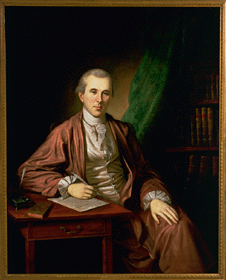I suspect most upper-level history students are quite capable of following the Turabian or Chicago styles themselves they put their minds to it, but I will provide here a little capsule summary of the style I use, which basically follows Turabian. I will try emphasize the particular types of sources most of you are using. These examples are in the style you would in a footnote or endnote. The best way to learn a citation style is to follow the pattern another scholar has used. If you need a very large number of detailed practical examples, covering many different types of sources, you could do a lot worse than studying the endnotes of
my book chapter on lobbying, which you should already have read.
DOCUMENTS IN PRIMARY SOURCE COLLECTIONS -- you should always be citing the individual documents, rather than the whole volume or series
The format for a letter is:
Author to Recipient, date, Lead or first editor of collection, ed.,
Title of collection (Place of publication: Publisher, Date or date range of publication), Volume:Page numbers
Examples:
James Madison to Thomas Jefferson, 10 Jan. 1796, Julian P. Boyd et al, eds.,
The Papers of Thomas Jefferson (Princeton: Princeton University Press, 1950-), 28:577.
John Beckley to James Madison, 10 Sept. 1795, William T. Hutchinson et al, eds.,
The Papers of James Madison (Vols. 1-10, Chicago: University of Chicago Press, 1962-1977; vols. 11-17, Charlottesville: University Press of Virginia, 1977-1991), 16:86.For other sorts of documents in the collections, you will need to list the author and title of the document instead of the sender and recipient, then the date and the other information.
You can cite more than one item in a note by separating the references with semi-colons. You should also shorten the references if you have to re-use them later in your paper. So the first example above could be shortened to: Madison to Jefferson, 10 Jan. 1796, Boyd, ed.,
Papers of Jefferson, 28:577. You have some freedom about how you shorten references. The main thing is to do it consistently.
NEWSPAPER ARTICLE -- don't worry about what database it came from; the publication information is what is important. Give an author or title if available, but know they often will not be. You can also use the pseudonym as the author or title, depending on the circumstances.
"From a George-Town Paper," Newark
Centinel of Freedom, 25 January 1797.
More later . . . ----------------
Now playing:
Love As Laughter - Paul Revere
